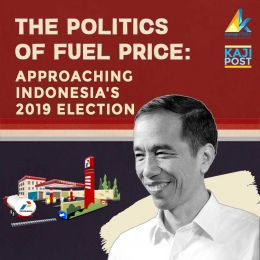Economic policy is rarely immune to the poisons of politics, which are ever stronger when an election approaches. Political candidates and parties become economically populist---in this case catering to popular demands when they are not always sound or sustainable---to help their reelection prospects.
Look no further than our own government as we near the 2019 election year. President Joko Widodo is already rolling out a series of price controls, along with some subsidy increases, as he is set to run for another term and face potentially tough competition from Prabowo Subianto.
Jokowi is reinforcing price controls across a wide range of commodities which include rice, sugar, coal, electricity, and oil fuel. Among them, oil fuel might be the most significant considering the sheer amount of fiscal cost it imposes, as well as Indonesia's long history of fuel subsidies and attempts to reform it.
Fuel price controls have even stirred drama; Pertamina's boss was fired soon after complaining about their implications. So what are the economic implications of fuel price controls, and how could we possibly circumvent them?
The Comeback of Fuel Subsidy
Indonesians are notoriously dependent on fuel subsidies, which cost an exorbitant Rp2600B in 2006-2016. The price of fuel in Indonesia is among the cheapest in the world and it was considered political suicide to change that. So it was a bold decision that Jokowi cut fuel subsidies soon after securing office. He reduced the budget for fuel subsidies from Rp46.79B in 2014 to Rp7.15B in 2017.
To be fair, the real amount of subsidy reduction might be less than the mentioned figures because Pertamina was still obligated to provide Premium at a ceiling price outside Java, Madura and Bali (Jamali). In other words, the government was shifting part of the subsidy burden from the national budget (APBN) to Pertamina.
Nevertheless, Jokowi's decision was applauded by many, not least because much of the fund was reallocated to ambitious infrastructure projects, which are considered more productive. The adverse impact of the subsidy cut on consumers was also subdued by the drop in world oil price that same year.
But with the presidential election incoming, fuel price control is being summoned back. Jokowi will be increasing subsidies by $588 million in 2018 in order to keep the prices of subsidized fuel fixed. The price freeze is promised to last until the end of 2019, conveniently after the election is over.
Moreover, the Ministry of Energy and Mineral Resources (ESDM) will be imposing a form of price control on non-subsidized fuel. Previously, fuel retailers such as Pertamina and Shell were free to set prices for non-subsidized fuels based on market prices. Now they will have to obtain government approval before changing those prices, with exception for industrial fuels.
While this is not an absolute price ceiling, it allows the government to forbid fuel retailers from raising prices on the grounds of limiting inflation and protecting consumers, even when the market price of oil is currently rising. Since these fuel prices receive no subsidy, it would be the fuel retailers that foot the bill (although there was a plan for a compensation fund from the government).








